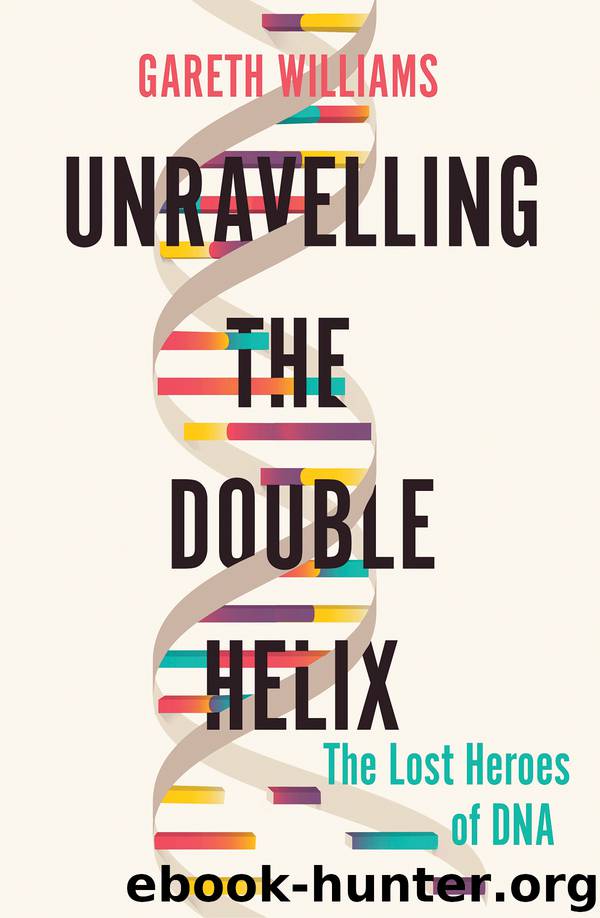Unravelling the Double Helix by Gareth Williams

Author:Gareth Williams
Language: eng
Format: epub
Publisher: Pegasus Books
Published: 2019-07-15T16:00:00+00:00
Golden ratios
Meanwhile, Erwin Chargaff had been struggling to pursue his vendetta against the tetranucleotide. His challenge was to pull the four bases out of the soup of DNA breakdown products, and to measure the levels of each one accurately and reproducibly.
Timely inspiration came when Ernst Vischer, a visiting biochemist from Miescher’s former department in Basel, went to hear a lecture about a new method to separate and assay individual amino acids. The lecturer was Archer Martin from Leeds, who with Richard Synge† had discovered that each amino acid migrates at its own speed through a sheet of damp filter paper and forms a specific spot that could be cut out and analysed. Vischer saw the potential for adapting this ‘paper chromatography’ to measure amounts of bases rather than amino acids. Starting with a strip of filter paper which Martin kindly tore off one of his demonstration experiments, Chargaff and Vischer sat down to make it work.
Within weeks of the Cold Spring Harbor meeting, they had used paper chromatography to measure each of the bases in DNA from calf thymus and spleen as well as yeast and tuberculosis bacilli. Consistent patterns began to emerge, which became stronger as they improved the method and diversified into DNA from a wider range of sources; these included human spermatozoa, in an exhaustive experiment that began with volunteers keen enough to produce (collectively) three-quarters of a pint of semen.
The ‘mathematical regularities’ in the proportions of the bases in DNA were later glorified with the title ‘Chargaff’s Rules’, but their discoverer was initially cautious about reading too much into his results, which he regarded as ‘noteworthy, though possibly no more than accidental’. To anyone with an open mind, Chargaff’s First Rule sounded the death knell of the tetranucleotide. None of the DNA sources showed the expected 25:25:25:25 per cent ratios for A:G:C:T that were dictated by Levene’s hypothesis. In calf thymus, for example, the A:G:C:T ratios were 30:20:20:30 per cent. Chargaff’s Second Rule states that the base composition of DNA is ‘characteristic of the species’ – i.e. constant for all the tissues of a given species – but varies between species. For example, tuberculosis bacilli showed a markedly different split from calf thymus, with A:G:C:T of 35:15:15:35 per cent.
Figure 18.3 Chargaff’s Rules.
Download
Unravelling the Double Helix by Gareth Williams.epub
This site does not store any files on its server. We only index and link to content provided by other sites. Please contact the content providers to delete copyright contents if any and email us, we'll remove relevant links or contents immediately.
| Fossils | Game Theory |
| Genetics | Molecular Biology |
| Organic | Paleontology |
Sapiens: A Brief History of Humankind by Yuval Noah Harari(13053)
Sapiens by Yuval Noah Harari(4537)
Homo Deus: A Brief History of Tomorrow by Yuval Noah Harari(4279)
Pale Blue Dot by Carl Sagan(4001)
Origin Story: A Big History of Everything by David Christian(3139)
Livewired by David Eagleman(3122)
Brief Answers to the Big Questions by Stephen Hawking(2878)
Inferior by Angela Saini(2831)
Origin Story by David Christian(2683)
The Evolution of Beauty by Richard O. Prum(2553)
Signature in the Cell: DNA and the Evidence for Intelligent Design by Stephen C. Meyer(2501)
The Gene: An Intimate History by Siddhartha Mukherjee(2491)
Aliens by Jim Al-Khalili(2382)
How The Mind Works by Steven Pinker(2214)
Sex at Dawn: The Prehistoric Origins of Modern Sexuality by Ryan Christopher(2150)
From Bacteria to Bach and Back by Daniel C. Dennett(2148)
A Short History of Nearly Everything by Bryson Bill(2135)
Endless Forms Most Beautiful by Sean B. Carroll(2083)
Who We Are and How We Got Here by David Reich(2059)
